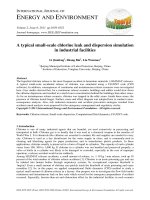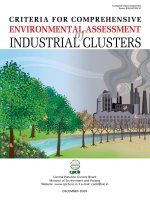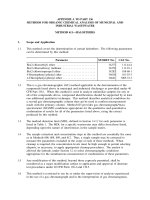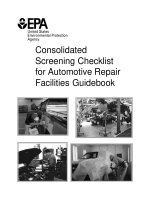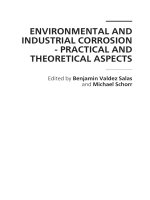UNIFIED FACILITIES CRITERIA (UFC) INDUSTRIAL VENTILATIONAPPROVED potx
Bạn đang xem bản rút gọn của tài liệu. Xem và tải ngay bản đầy đủ của tài liệu tại đây (1.9 MB, 92 trang )
UFC 3-410-04N
25 October 2004
UNIFIED FACILITIES CRITERIA (UFC)
INDUSTRIAL VENTILATION
APPROVED FOR PUBLIC RELEASE; DISTRIBUTION UNLIMITED
UFC 3-410-04N
25 October 2004
UNIFIED FACILITIES CRITERIA (UFC)
INDUSTIAL VENTILATION
Any copyrighted material included in this UFC is identified at its point of use.
Use of the copyrighted material apart from this UFC must have the permission of the
copyright holder.
U.S. ARMY CORPS OF ENGINEERS
NAVAL FACILITIES ENGINEERING COMMAND (Preparing Activity)
AIR FORCE CIVIL ENGINEER SUPPORT AGENCY
Record of Changes (changes are indicated by \1\ /1/)
Change No. Date Location
(NOTE: When a UFC supersedes another service publication, include a supersedure
statement in accordance with the following example.)
_____________
This UFC supersedes Military Handbook 1003/17C, dated February 1996.
UFC 3-410-04N
25 October 2004
Contents
Page
CHAPTER 1 INTRODUCTION
1-1 SCOPE 1-1
1-2 PURPOSE OF CRITERIA 1-1
1-3 SPECIFIC PROCESSES 1-1
CHAPTER 2 GENERAL REQUIREMENTS
2-1 GENERAL CRITERIA 2-1
2-2 COORDINATION 2-1
2-3 DESIGN PROCEDURE 2-1
2-3.1 Step 1 2-1
2-3.2 Step 2 2-2
2-3.3 Step 3 2-2
2-3.4 Step 4 2-2
2-3.5 Step 5 2-2
2-3.6 Step 6 2-2
2-3.7 Step 7 2-2
2-3.8 Step 8 2-2
2-4 DESIGN CRITERIA 2-2
2-4.1 Ductwork 2-2
2-4.2 Fans 2-3
2-4.3 Exhaust stacks 2-4
2-4.4 Air Pollution Control Equipment 2-4
2-4.5 Replacement Air 2-4
2-5 CONTROLS 2-7
2-5.1 Gauges and Sensors 2-7
2-5.2 Interlocks 2-8
2-5.3 Annunciator Panel 2-8
2-6 OPERATIONAL CONSIDERATIONS 2-9
2-6.1 Provision for System Testing 2-9
2-6.2 Energy Conservation 2-9
2-6.3 Recirculation 2-9
2-6.4 Maintenance 2-10
2-7 SAFETY AND HEALTH CONSIDERATIONS 2-10
2-7.1 Posting 2-10
2-7.2 Noise 2-10
2-7.3 Respiratory Protection 2-10
2-7.4 Emergency Showers and Eyewash Stations 2-11
2-7.5 Hygiene Facilities 2-11
2-8 COMMISSIONING 2-11
CHAPTER 3 ASBESTOS DELAGGING FACILITIES
i
UFC 3-410-04N
25 October 2004
3-1 FUNCTION 3-1
3-2 OPERATIONAL CONSIDERATIONS 3-1
3-2.1 Airborne Contamination 3-1
3-2.2 Heat Stress 3-1
3-2.3 Employee Workflow 3-1
3-3 TYPICAL FLOOR PLANS 3-1
3-4 DESIGN CRITERIA 3-2
3-5 EXHAUST AIR 3-2
3-5.1 Hood Design 3-2
3-5.3 Ductwork 3-3
3-5.4 Fans 3-4
3-5.5 Weather Stack Design and Location 3-4
3-5.6 Air Cleaning Devices 3-4
3-5.7 Industrial Vacuum System 3-5
3-5.8 Replacement Air 3-7
3-5.9 System Controls 3-7
3-6 SAFETY AND HEALTH CONSIDERATIONS 3-8
CHAPTER 4 OTTO FUEL II FACILITIES
4-1 FUNCTION 4-1
4-2 OPERATIONAL CONSIDERATIONS 4-1
4-3 DESIGN CRITERIA 4-1
4.3.1 Exhaust Air for MK-46 Ventilated Spaces 4-1
4-3.2 Exhaust Air for MK-48 Ventilated Spaces 4-5
4-3.3 Weather Stack Design and Location 4-9
4-3.4 Air Cleaning Devices 4-9
4-3.5 Replacement Air 4-9
4-3.6 Heating and Air Conditioning 4-11
4-4 SYSTEM CONTROLS 4-11
4-5 SAFETY AND HEALTH CONSIDERATIONS 4-11
4-5.1 Emergency Eyewash and Shower Stations 4-11
CHAPTER 5 FIBERGLASS REINFORCED PLASTIC FABRICATION
AND REPAIR FACILITIES
5-1 FUNCTION 5-1
5-2 OPERATIONAL CONSIDERATIONS 5-1
5-3 FLOOR PLAN 5-1
5-4 DESIGN CRITERIA 5-2
5-4.1 Exhaust Air System 5-2
5-4.2 Hood Design 5-2
5-4.3 Ductwork 5-6
5-4.4 Fans 5-6
5-4.5 Weather Stack Design and Location 5-6
5-4.6 Air Cleaning Devices 5-6
5-4.7 Industrial Vacuum System 5-7
5-5 REPLACEMENT AIR 5-8
ii
UFC 3-410-04N
25 October 2004
5-6 SYSTEM CONTROLS 5-8
5-7 SAFETY AND HEALTH CONSIDERATIONS 5-9
CHAPTER 6 ABRASIVE BLASTING FACILITIES
6-1 FUNCTION 6-1
6-2 OPERATIONAL CONSIDERATIONS 6-1
6-3 DESIGN CRITERIA 6-1
6-3.1 Exhaust Air 6-1
6-3.2 Blasting Cabinets 6-1
6-3.3 Walk-in Blasting Enclosures 6-1
6-3.4 Access Doors and Observation Windows 6-4
6-3.5 Air Cleaning Devices 6-4
6-3.6 Recirculation 6-4
6-3.7 Media Reclamation 6-4
6-3.8 Ductwork 6-4
6-3.9 Fans 6-5
6-3.10 Weather Stack Design and Location 6-5
6-3.11 Replacement Air Ventilation Systems 6-5
6-3.12 Heating and Air Conditioning 6-5
6-3.13 System Controls 6-5
6-4 SAFETY AND HEALTH CONSIDERATIONS 6-5
6-4.1 Respiratory Protection 6-5
6-4.2 Air Supply and Air Compressors 6-5
6-4.3 Noise 6-5
6-4.5 Hygiene Facilities 6-6
CHAPTER 7 WOOD SHOP FACILITIES
7-1 FUNCTION 7-1
7-2 OPERATIONAL CONSIDERATIONS 7-1
7-3 FLOOR PLAN CRITERIA 7-1
7-4 DESIGN CRITERIA 7-1
7-4.1 Exhaust Air System 7-1
7-4.2 Hood Design 7-2
7-4.3 Floor Sweeps 7-2
7-4.4 Ductwork 7-2
7-4.5 Blast Gates 7-2
7-4.6 Duct Support 7-3
7-4.7 Clean Out Panels 7-3
7-4.8 Exhaust Fans 7-3
7-4.9 Weather Stack Design and Location 7-3
7-4.10 Air Cleaning Devices 7-3
7-4.11 Heating and Air Conditioning 7-3
7-5 SAFETY AND HEALTH CONSIDERATIONS 7-3
CHAPTER 8 BATTERY MAINTENANCE FACILITIES
iii
UFC 3-410-04N
25 October 2004
8-1 FUNCTION 8-1
8-2 OPERATIONAL CONSIDERATONS 8-1
8-3 DESIGN CRITERIA 8-1
8-3.1 Exhaust System 8-1
8-3.2 Ductwork 8-4
8-3.3 Fans and Motors 8-4
8-3.4 Weather Stack Design and Location 8-4
8-3.5 Air Cleaning Device 8-4
8-3.6 Replacement Air 8-4
8-3.7 System Controls 8-4
8-4 SAFETY AND HEALTH CONSIDERATIONS 8-4
CHAPTER 9 PAINT SPRAY BOOTHS
9-1 FUNCTION 9-1
9-2 OPERATIONAL CONSIDERATIONS 9-1
9-2.1 Painting Equipment Types 9-1
9-3 DESIGN CRITERIA 9-1
9-3.1 Walk-In Spray Paint Booths 9-1
9-3.2 Storage and Mixing Room 9-6
9-3.3 Paint Mix Hoods 9-6
9-4 FANS AND MOTORS 9-6
9-5 REPLACEMENT AIR 9-6
9-5.1 Air Distribution 9-7
9-5.2 Heating and Air Conditioning 9-7
9-6 SYSTEM CONTROLS 9-7
9-7 RESPIRATORY PROTECTION 9-7
CHAPTER 10 AIRCRAFT CORROSION CONTROL HANGARS
10-1 FUNCTION 10-1
10-2 OPERATIONAL CONSIDERATIONS 10-1
10-3 DESIGN CRITERIA 10-1
10-3.1 Exhaust Air System 10-1
10-3.2 Ventilation System Configurations 10-2
10-3.3 Exhaust Filtration System 10-3
10-3.4 Auxiliary Walk-in Paint Spray Room 10-3
10-3.5 Storage and Mixing Room 10-3
10-3.6 Paint Mixing Hood 10-3
10-4 FANS AND MOTORS 10-3
10-5 REPLACEMENT AIR 10-3
10-5.1 Heating and Air Conditioning 10-4
10-6 SYSTEM CONTROLS 10-4
10-7 RESPIRATORY PROTECTION 10-4
GLOSSARY Glossary-1
ABBREVIATIONS AND ACRONYMS Glossary-4
iv
UFC 3-410-04N
25 October 2004
APPENDIXES
A - References A-1
B - Letters Related to Airflow Requirements for Walk-in Spray Paint Booths B-1
C - Letters Related to Airflow Requirements for Aircraft Corrosion Control
Hangars C-1
FIGURES
2-1 Exhaust stack designs 2-4
2-2 Decision tree for replacement air design 2-5
2-3 Plenum design with perforated duct 2-6
2-4 Plenum design without perforated duct 2-7
2-5 Annunciator panel 2-9
3-1 Delagging facility floor plan 3-2
3-2 Exhaust hood for high profile work pieces 3-3
3-3 Exhaust hood for low profile work pieces 3-4
3-4 Sequence of air cleaning devices for asbestos delagging 3-5
3-5 Exhaust and vacuum system schematic diagram 3-7
4-1 Layout for MK-46 fuel/defuel and afterbody breakdown room 4-2
4-2 Series of hoods in MK-46 shop 4-2
4-3 MK-46 standup backdraft hood 4-3
4-4 MK-46 workbench hood 4-4
4-5 MK-46 parts washer hood 4-4
4-6 Typical MK-48 ventilated space layout 4-5
4-7 MK-48 afterbody teardown hood 4-6
4-8 MK-48 workbench hood 4-7
4-9 MK-48 parts washer hood 4-7
4-10 MK-48 hood sequence afterbody teardown and accessories rooms 4-8
4-11 MK-48 refueling hood 4-9
4-12 Vertical distribution method 4-10
4-13 Horizontal distribution method 4-10
5-1 Floor plan for FRP facility 5-2
5-2 Workbench hood 5-4
5-3 Floor exhaust 5-4
5-4 Spray up booth 5-5
5-5 Ventilated sink 5-5
5-6 Exhaust system schematic 5-7
6-1 Downdraft blast enclosure 6-2
6-2 Crossdraft blast enclosure 6-3
7-1 Floor sweep 7-2
v
UFC 3-410-04N
25 October 2004
8-1 Ventilation system for battery maintenance facilities 8-2
9-1 Walk-in downdraft paint booth 9-3
9-2 Drive through crossdraft paint booth with mechanical replacement air 9-4
9-3 Drive through crossdraft paint booth with no mechanical replacement air 9-5
9-4 Paint mixing hood and work bench 9-6
10-1 Crossdraft corrosion control hangar 10-2
10-2 Hangar door and exhaust plenum details 10-3
TABLES
3-1 Minimum Volumes and Vacuum Hose Size for Asbestos Operations 3-6
5-1 Recommended Hoods, Capture Velocity and Air Pollution Device 5-3
vi
UFC 3-410-04N
25 October 2004
CHAPTER 1
INTRODUCTION
1-1 SCOPE. This Unified Facilities Criteria (UFC) provides criteria for the
design of ventilation systems that control contaminants generated from industrial
processes.
1-2 PURPOSE OF CRITERIA. Criteria are developed to define requirements
during the design of industrial ventilation systems. Chapter 2 provides general criteria and
Chapters 3 through 10 provide criteria for specific processes. Use the general criteria
presented in Chapter 2 along with the applicable specific criteria presented in Chapters 3
through 10 to design the ventilation system. For all other ventilation applications, use the
criteria in Chapter 2.
Criteria contained in this UFC should be interpreted as the minimum
required and should be improved where current technology or situation warrants. Users
of this UFC are advised to consult the most current edition of the standards.
This UFC does not incorporate individual state and local environmental
requirements. It is the sole responsibility of the cognizant design personnel to design
an industrial ventilation system that complies with state and local environmental
requirements.
1-3 SPECIFIC PROCESSES. The specific processes addressed in this
handbook are asbestos delagging, torpedo refurbishing (Otto Fuel II), fiberglass reinforced
plastic fabrication and repair, abrasive blasting, woodworking, battery maintenance, paint
spray booths, and aircraft corrosion control hangers.
1-1
UFC 3-410-04N
25 October 2004
CHAPTER 2
GENERAL REQUIREMENTS
2-1 GENERAL CRITERIA. Installing engineering controls is the preferred
method of controlling hazardous processes as specified in 29 CFR 1910.1000(e), Air
Contaminants and OPNAVINST 5100.23, Navy Occupational Safety and Health
Program Manual. Properly designed industrial ventilation systems are the most
common form of engineering controls.
2-2 COORDINATION. Form a project design team to direct the design of
industrial ventilation projects. Include in the design team representatives from:
• Effected industrial shop.
• Public works.
• Health and safety office.
• Cognizant Regional Engineering Office (REO) (for example: Navy
Engineering Field Division, Army Corps of Engineers Division, and Air
Force major command engineering office). The REO representative
establishes a design team and acts as the team leader in all cases, except
when the cognizant REO grants a variance.
• Industrial hygiene and safety offices.
NOTE U.S. NAVY: BUMED or activity IH. Use Naval Environmental
Health Center as a back-up.
• System command program manager (where applicable).
• System safety engineer.
• Environmental manager.
2-3 DESIGN PROCEDURE. Refer to the ACGIH IV Manual, Industrial
Ventilation; A Manual of Recommended Practice, Chapter 5, "Exhaust System Design
Procedure," for system design calculations. Design all industrial ventilation systems in
accordance with paragraphs 2-3.1 through 2-3.8.
2-3.1 Step 1. Identify all significant contaminant sources that require ventilation
control. Request the local industrial hygiene office to provide a source characterization
with area diagrams of the contaminant sources, and employee work areas. Also,
2-1
UFC 3-410-04N
25 October 2004
consider how the system being designed might affect the performance of any existing
processes, industrial ventilation systems or HVAC systems.
2-3.2 Step 2. Consider how the facility is to be used or expanded in the future.
It may be possible to initially specify fans that are capable of handling future needs at
minimal increased cost.
2-3.3 Step 3. Select or design the exhaust hood that best suits the work piece
or operation. Design the exhaust hood to enclose the work piece or operation as much
as possible. This will reduce the ventilation rates required to provide contaminant
control. This UFC provides optimum exhaust hood designs for many of the operations
covered.
2-3.4 Step 4. Determine the capture velocity required to control generated
contaminants. Capture velocities in this UFC are specified assuming there are no cross
drafts or turbulence that adversely affects the capture efficiency. Reduce potential for
cross drafts or turbulence near a given exhaust hood by properly locating and designing
the hood with baffles, and also by designing the replacement air system to complement
the exhaust system.
2-3.5 Step 5. Determine the exhaust volumetric flow, in cubic meters per
second (m
3
/s) [cubic feet per minute (cfm)], required to maintain the capture velocity
determined in paragraph 2-3.4.
2-3.6 Step 6. Create a line drawing of the proposed system. Include plan and
elevation dimensions, fan location and air cleaning device location. Identify each hood,
branch duct and main duct sections.
2-3.7 Step 7. Size ductwork using the balance by design or the blast gate
method. Maintain the required minimum transport velocity throughout the system.
2-3.8 Step 8. Determine requirements for replacement air. Based on the
process, determine if the room should be under slightly negative, neutral or slightly
positive pressure with respect to the surrounding area. The surrounding area can be
either outside the building envelope or an adjacent room or hallway. Determine if
tempered replacement air is needed.
2-4 DESIGN CRITERIA. Several design criteria are common to all industrial
ventilation systems; use the ACGIH IV Manual for primary guidance. See paragraphs 2-
4.1 through 2-4.5 for additional guidance. Chapters 3 through 10 provide design
guidance for specific types of facilities.
2-4.1 Ductwork. In addition to the recommendations of the ACGIH IV Manual,
consider the following when designing a ventilation system.
2-2
UFC 3-410-04N
25 October 2004
a. Specify duct gage, reinforcement schedule and hanger design and
spacing, in accordance with SMACNA RIDCS, Round Industrial Duct
Construction Standards for round duct and SMACNA RTIDCS,
Rectangular Duct Construction Standards for rectangular duct.
b. Install clean-out doors in ductwork that conveys particulate material
such as wood dust or blasting grit. Mount clean-out doors on top half of
horizontal runs near elbows, junctions, and vertical runs.
2-4.2 Fans
2-4.2.1 Selection. Except where specified below, fan selection criteria for
replacement air fans and exhaust air fans are identical.
a. Select exhaust system industrial fans that meet design pressure and
volume flow rate requirements and have the AMCA-certified performance
seal. The design pressure requirement must account for any system
effects caused by non-uniform airflow into or out of the fan. See AMCA
201, Fans and Systems for more information on system effects. Specify a
fan class that is appropriate for the design operating point. Do not select
fans with forward curved blades.
b. When selecting fan capacity, consider if the process room pressure
will be positive, negative or neutral with respect to the external areas.
Select a fan that will provide the necessary volumetric flow rate to
maintain the desired process room pressure. Ensure that all sources of
exhaust air are considered when selecting fan capacity. See paragraph 2-
4.5 for more details.
c. Specify fan shafts that have a uniform diameter along the entire
length. Use bearings that are rated with an average life of 200,000 hours.
d. Select only energy efficient motors. Select the motor to handle cold
startup amperage for nonstandard air processes.
e. Specify vibration-isolating couplings at the fan inlet and outlet. Mount
all fans on vibration isolating bases.
f. If the planner's forecasts change in the processes to occur within the
next couple of years, which would require an increase in the amount of
replacement or exhaust air, then consider purchasing a larger capacity fan
and oversized wiring.
2-4.2.2 Location. Locate the exhaust fan after the air pollution control equipment
to protect fan blades from contaminated air-stream. Provide access for maintenance to
all fans, including ladders and guardrails where necessary. Refer to NFPA 70, National
2-3
UFC 3-410-04N
25 October 2004
Electrical Code for motor controller and disconnect location requirements. In all cases,
install exhaust fans outside the building that they serve. Installing the fan outside the
building envelope will isolate the working space from contaminants during fan
maintenance, minimize noise inside the building, and ensure that ductwork within the
building envelope is under negative pressure.
2-4.3 Exhaust Stacks
2-4.3.1 Design Considerations. Refer to the ACGIH IV Manual for exhaust
stack design criteria. The best designs are cylindrical, vertical discharge stacks as
shown in Figure 2-1. The best protection from rain, when the ventilation system is not
running, is the “offset stack” design C, as shown in Figure 2-1. Water may still enter the
system with straight stack design A. Provide a means to drain water from the fan
housing.
Figure 2-1. Exhaust stack designs.
2-4.3.2 Location and Structural Considerations. Refer to ASHRAE Handbook,
Fundamentals for information on airflow around buildings. Do not select stack locations
based on prevailing winds. A stack must provide effluent dispersion under all wind
conditions. Refer to UFC 1-200-01, Design: General Requirements for exhaust stack
structural design considerations. Some structural considerations are wind load,
lightning protection, and stack support. Refer to MIL-HDBK-1004/6, Lightning (and
Cathodic) Protection and SMACNA GSSDC, Guide for Steel Stack Design and
Construction for additional information.
2-4.4 Air Pollution Control Equipment. Requirements for air pollution
equipment vary by process and geographical region in the United States. Contact the
2-4
UFC 3-410-04N
25 October 2004
local activity environmental manager to determine the pollution control requirements for
the process.
2-4.5 Replacement Air. Replacement air is as important as exhaust air in
controlling industrial process contaminants. Properly designed replacement air will (1)
ensure that exhaust hoods have enough air to operate properly, (2) help to eliminate
cross-drafts through window and doors, (3) ensure proper operation of natural draft
stacks, (4) eliminate cold drafts on workers, and (5) eliminate excessive differential
pressure on doors and adjoining spaces. The method of distributing replacement air
and the quantity of replacement air are critical with respect to exhaust air. Design the
replacement air system in accordance with the decision tree shown in Figure 2-2.
2-5
UFC 3-410-04N
25 October 2004
Figure 2-2. Decision tree for replacement air design.
2-4.5.1 Space Pressure Modulation. Control the ventilated space pressure by
modulating the quantity of replacement air. Use a variable frequency drive (VFD) motor
to control the fan speed (see MIL-HDBK-1003/3, Heating, Ventilating, Air Conditioning,
and Dehumidifying Systems for information of VFD motors). Using barometric dampers
to control replacement air quantity is inefficient and unreliable. Sensor controlled
transfer grilles are acceptable provided there will not be a problem with contaminated
migration.
2-6
UFC 3-410-04N
25 October 2004
2-4.5.2 Plenum Design. Use perforated plate to cover as much of the ceiling (or
wall opposite the exhaust hood(s)) as practical. The diameter of the perforation should
be between 6.3 mm and 9.5 mm (1/4 in and 3/8 in). Perforated plenums work best
when ceiling height is less than 4.58 m (15 ft). Use either of the following two choices
for replacement air plenum design:
a. Design for 5.1 m/s (1,000 fpm) replacement air velocity through the
open area of the perforated plate if perforated duct is used inside the
plenum as shown in Figure 2-3.
b. Design for 10.2 m/s (2,000 fpm) replacement air velocity through the
open area of the perforated plate if the plenum is served with ducts using
diffusers, grills or registers as shown in Figure 2-4.
Figure 2-3. Plenum design with perforated duct.
2-7
UFC 3-410-04N
25 October 2004
Figure 2-4. Plenum design without perforated duct.
2-4.5.3 Perforated Duct Design. Use perforated duct to evenly distribute the
flow of replacement air inside a plenum or use alone when ceiling height is greater than
4.58 m (15 ft). Manufacturers provide several different types and sizes of perforated
duct. Use recommendations from the manufacturer for duct design. The manufacturer
will not only recommend the size, shape, and type of the required perforated duct, but
also the location of the orifices and reducers to distribute the air properly.
2-5 CONTROLS. Provide industrial ventilation system controls and
associated alarms to ensure contaminant control, space specific balance and
conditioning, a safe and healthy work environment, and system malfunction notification.
2-5.1 Gauges and Sensors. Specify gauges and sensors to provide
continuous monitoring of system performance. The minimum requirements are:
2-5.1.1 Differential pressure sensors, with gauge readouts, across each
replacement air filter section. Set points on the gauge to trigger an alarm when the
pressure drops or gains across the filter exceed the manufacturer's recommended
value. A pressure drop occurs when there is a blow through a filter and a pressure gain
occurs when the filter gets loaded.
2-5.1.2 Operating light on replacement air system fan motor.
2-8
UFC 3-410-04N
25 October 2004
2-5.1.3 Static pressure sensor at the outlet of the replacement air fan with a
gauge readout. Set the points on the gauge to trigger an alarm when the pressure is
lower than the recommended range (as determined by baseline testing).
2-5.1.4 Hood static pressure sensor, for critical processes or process where
extremely toxic substances are used, with a gauge mounted in a conspicuous place
near the hood. Set the points on the gauge to trigger an alarm when the static pressure
is lower or higher than the recommended range (as determined by baseline testing). Do
not use the type of inline flow sensor, which measures the pressure drop across an
orifice plate. Use only a static pressure tap and differential pressure gauge.
2-5.1.5 Differential pressure sensor across each exhaust air-cleaning device with
gauge readout. Set points on the gauge to trigger an alarm when the pressure drop
across the device exceeds the manufacturer's recommended value.
2-5.1.6 Static pressure sensor at the exhaust fan inlet with gauge readout. Set
the points on the gauge to trigger an alarm when the pressure is lower than the
recommended range (as determined by baseline testing).
2-5.1.7 Operating light on exhaust air system motor. When a sensor indicates a
malfunction, trigger an alarm that is both audible and visible in the shop space.
2-5.1.8 Operating ranges on all gauges clearly marked. Locate gauges on an
annunciator panel (except hood static pressure gauges). Provide a 3-way valve at each
gauge connection for cleanout and calibration; see Figure 2-5.
2-5.1.9 Place room differential pressure sensors away from doors, windows, and
replacement air discharge.
2-5.2 Interlocks. Provide an interlocked on-off switch so that the replacement
air and exhaust air systems operate simultaneously. When there are multiple fans,
clearly label which exhaust fan is interlocked with which supply fan.
2-5.3 Annunciator Panel. Provide an annunciator panel to continuously
monitor ventilation system performance. Locate the panel so it is accessible to shop
personnel. The panel must include, but is not limited to, all gauges (except hood static
pressure gauges) described in paragraph 2-5.1. Mount fan motor operating lights and
interlocked ON/OFF switch on the panel. The interlocked switches must clearly show
which exhaust and supply fans are interlocked, where multiple fans are used. The
panel should indicate what action to take when operation falls outside the prescribed
ranges. For example, “examine/replace filter on R.A. unit when this gauge reads
outside indicated range.”
2-9
UFC 3-410-04N
25 October 2004
Figure 2-5. Annunciator Panel.
2-6 OPERATIONAL CONSIDERATIONS
2-6.1 Provision for System Testing. Provide access to the fan and motor to
measure voltage, amperage, and fan speed. Specify that all testing will be done in
accordance with the ACGIH IV Manual, Chapter 9, “Monitoring and Testing of
Ventilation Systems.”
2-6.2 Energy Conservation. Incorporate applicable energy conservation
measures in the design of all industrial ventilation systems. Criteria herein minimize
volume flow rates through appropriate designs. Evaluate life cycle costs for heat
recovery systems and specify when appropriate. Refer to ASHRAE Handbook, HVAC
Systems and Equipment and MIL-HDBK-1003/3 for details.
2-6.3 Recirculation. Industrial ventilation systems use a large quantity of air.
Exhaust air recirculation is discouraged for most Naval industrial processes and
prohibited by OPNAVINST 5100.23 for processes generating lead and asbestos.
Follow the re-circulated air guidelines set forth in UFC 3-600-01, Design: Fire Protection
Engineering for Facilities and NFPA 654, Standard for the Prevention of Fire and Dust
Explosions from the Manufacturing, Processing, and Handling of Combustible
Particulate Solids for fire protection; the ACGIH IV Manual and ANSI Z9.7, Recirculation
of Air from Industrial Process Exhaust Systems for health protection, and the applicable
OSHA standards when recirculation is included in the design.
2-10
UFC 3-410-04N
25 October 2004
2-6.4 Maintenance. Require the contractor provide an operation and
maintenance manual for the system and also provide hands-on training for maintenance
and shop personnel.
2-7 SAFETY AND HEALTH CONSIDERATIONS
2-7.1 Posting. For those systems where the replacement air is critical to the
proper operation of the system, consider posting the following sign at each entrance to
the ventilated space:
KEEP DOOR CLOSED
THIS DOOR MUST BE CLOSED FOR
EFFECTIVE CONTROL OF CONTAMINANTS
2-7.2 Noise. Use engineering controls as the primary means of protecting
personnel from hazardous noise. It is cheaper to eliminate potential noise problems
during the design or procurement stages, than it is to retrofit or modify after installation.
Determine the acoustic environment of any kind of activity in advance, both to fulfill the
design goals and prevent the need for corrections at a later stage.
2-7.2.1 Criteria. Specify the lowest noise emission level that is technologically
and economically feasible. Each DOD service branch has a permissible noise level
specified in its safety and health manual. It is not adequate to specify that individual
pieces of equipment do not produce noise levels in excess of that permissible level.
Determine the sound power levels for each piece of equipment. Use this information to
predict the acoustic characteristics of the workspace and the resulting ambient noise
level. Specify the appropriate noise control method if the total predicted ambient noise
level is in excess of the requirements in the applicable safety and health manual. For
additional information on noise control refer to UFC 3-450-01, Design: Noise and
Vibration Control; DHEW 79-117, NIOSH Industrial Noise Control Manual; OSHA Pub
3048, Noise Control, A Guide for Workers and Employees; and NAVFAC P-970,
Protection Planning in the Noise Environment.
2-7.3 Respiratory Protection. 29 CFR 1910.134(d), Respiratory Protection
specifies requirements for respiratory protection. Consult with an industrial hygienist or
occupational health specialist to determine the appropriate type of respiratory protection
required for each process.
2-7.3.1 Breathing Air. Breathing air for supplied air respirators must meet grade
D standards as required by 29 CFR 1910.134(d) and defined in Compressed Gas
Association Specification for Air G-7.1. Breathing air couplings must not be compatible
with outlets for non-respirable worksite air or other gas systems. Consider providing
2-11
UFC 3-410-04N
25 October 2004
multiple connection ports for airline respirator hoses to allow worker mobility. Consider
installing a panel to permit the IH to test air quality on a routine basis.
NOTE for USAF: The test panel is required for quarterly testing.
2-7.3.2 Air Compressors. Oil lubricated breathing air compressors require a
high temperature or carbon monoxide alarm or both. If only a high temperature alarm is
used, the air supply must be monitored to ensure the breathing air does not exceed 10
parts per million (ppm) carbon monoxide. Compressors that are not oil lubricated must
still have the carbon monoxide level monitored to ensure it is below 10 ppm.
Compressors used to supply breathing air must be constructed and situated to prevent
entry of contaminated air into the air supply system. The breathing air compressor must
minimize moisture content so that the dew point is 5.56
o
C (10
o
F) below the ambient
temperature. The breathing air system must have suitable inline air-purifying sorbent
beds and filters. Sorbent beds and filter will have to be maintained per manufacturer’s
instructions.
2-7.4 Emergency Showers and Eyewash Stations. Provide where required.
Design in accordance with UFC 3-420-01, Design: Plumbing Systems.
2-7.5 Hygiene Facilities. These facilities are adjacent to or nearby the
operation when employees are exposed to certain stressors such as asbestos,
cadmium, lead, etc. The facilities may be as simple as a hand washing station or as
complicated as multiple clean/dirty rooms in an asbestos delagging facility. Consult with
the local industrial hygiene department to determine the extent of and location for these
facilities.
2-8 COMMISSIONING. This process begins before the conceptual design is
complete. It is a strategy that documents the occupants’ needs, verifies progress and
contract compliance and continues throughout the design, build and acceptance
process. DOD projects and construction offices have long used parts of the
commissioning process for military construction (MILCON) and some smaller projects.
To ensure that issues specific to ventilation are not overlooked, consider using ASHRAE
Guideline 1, The HVAC Commissioning Process.
2-12
UFC 3-410-04N
25 October 2004
CHAPTER 3
ASBESTOS DELAGGING FACILITIES
3-1 FUNCTION. An asbestos delagging facility provides a complete workshop
to remove asbestos insulation from piping and mechanical equipment during ship repair.
The ventilation system design discussed in this section is for activities with extensive
asbestos removal operations. The design includes: shop and equipment space, clean
and dirty locker rooms for men and women, and administrative space to support the
coordination and monitoring of facility operation.
3-2 OPERATIONAL CONSIDERATIONS
3-2.1 Airborne Contamination. When asbestos insulation is delagged, the
asbestos fibers are dispersed into the air, creating a health hazard. 29 CFR 1910.1001,
Asbestos, General Industry and 29 CFR 1915.1001, Asbestos, Shipyards dictate
protective measures for workers in these facilities, including respirator protection and
impermeable outerwear. The regulations also prescribe wetting the asbestos material
with amended water (water containing a surfactant), if practicable, to reduce the
potential for asbestos fibers to become airborne.
3-2.2 Heat Stress. The physical nature of the work and impermeable outer
garments worn by the workers creates heat stress conditions. Provide supplied air
respirators with vortex tubes as specified in EPA-560-OPTS-86-001, A Guide to
Respiratory Protection for the Asbestos Abatement Industry. Consider cooling the
replacement air when supplied air respirators are not available. Consider using "micro
climate cooling" or "cool suits," mechanically cooled garments, for individual workers.
3-2.3 Employee Workflow.
Workers enter the clean locker rooms through the
administrative area. They put on protective outerwear and proceed to the shop area.
After performing delagging, workers vacuum their protective outerwear and dispose of
them in containers provided in the decontamination area. They enter the dirty locker
rooms and remove the remainder of their work garments. Workers then proceed to the
clean locker rooms via the showers, which act as a barrier to the migration of asbestos
fibers.
3-3 TYPICAL FLOOR PLANS. Design floor plans to meet the requirements of
29 CFR 1910.1001 and 29 CFR 1915.1001 and paragraph 3-2.3. Figure 3-1 shows a
sample delagging facility floor plan.
3-1
UFC 3-410-04N
25 October 2004
Figure 3-1. Delagging facility floor plan.
3-4 DESIGN CRITERIA. Design the facility using general technical
requirements in Chapter 2 of this UFC and the specific requirements in this Chapter.
3-5 EXHAUST AIR. Design the exhaust air system to generate a minimum
capture velocity of 0.762 m/s (150 fpm) to capture all the contaminants at the source.
3-5.1 Hood Design. Design asbestos delagging hood to enclose the work
piece as much as possible. Do not use small portable hoods with flexible ductwork
because they do not provide consistent capture.
3-5.1.1 Typical Hood Design for High Profile Work Pieces. Figure 3-2 shows a
hood design consisting of a workbench with a central, circular area. Mount the circular
area on sealed bearings to allow easy turning of heavy work pieces. This design is best
for high profile work pieces (for example, boilers, pumps). The hood captures
contaminants through the slots into an exhaust plenum. Design each hood with:
a. Two cleanout doors on the front and two doors on the sides of the hood
for easy access to asbestos debris. Provide two small cutouts in the outer
3-2
UFC 3-410-04N
25 October 2004
corners of the workbench to place large pieces of lagging in double
bagged containment.
b. The top baffle swings up to allow access to overhead cranes.
Figure 3-2. Exhaust hood for high profile work pieces.
3-5.1.2 Typical Hood Design for Low Profile Work pieces. Figure 3-3 shows a
hood design consisting of a workbench with a grating strong enough to support the
heaviest expected work piece. This is a downdraft hood that draws small pieces of
lagging through the grating. The perforated plate below the grating creates even airflow
over the grating. This design is best for low profile work pieces such as piping. Design
each hood with stands and swinging baffles on each end to accommodate long work
pieces (e.g., pipes).
3-5.3 Ductwork. Size the exhaust ductwork to provide a minimum transport
velocity of 25.4 m/s (5,000 fpm). The high velocity is necessary because the practice of
wetting the fibers makes them heavier and more difficult to transport. See paragraph 2-
4.1 for general duct considerations.
3-3
UFC 3-410-04N
25 October 2004
Figure 3-3. Exhaust hood for low profile work pieces.
3-5.4 Fans. See paragraph 2-4.2 for general fan considerations.
3-5.5 Weather Stack Design and Location. See paragraph 2-4.3.
3-5.6 Air Cleaning Devices. A delagging facility requires multistage filtering,
which consists of a fabric filter collector, prefilters, a mist eliminator, and high efficiency
particulate air (HEPA) filters. Prefilters extend the life of the HEPA filters. Use "bag in,
bag out" styles of HEPA filters, which allow for safe replacement of the filter element
without exposure to asbestos. A mist eliminator before the HEPA filter protects it from
the moisture generated during asbestos removal.
a. Have all collectors deliver the collected asbestos to a common pickup
point to minimize the risk of exposure. Provide a double acting valve at
each collector hopper throat, in accordance with the ACGIH IV Manual,
Chapter 4.
b. Use a single chamber, shaker type collector to minimize the number
of collection points.
3-5.6.1 Filter Efficiency. The fabric filter collector requires a minimum efficiency
reporting value (MERV) of not less than 15 in accordance with ASHRAE 52.2, Method
3-4
